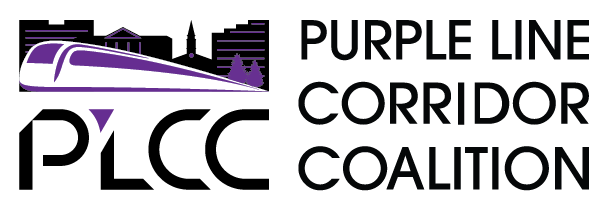Purple Line Communities Examine Opportunities “Beyond the Tracks”
COLLEGE PARK, Md. – In 2015, the Maryland Transit Authority (MTA) is expected to break ground on the Purple Line, a 16-mile, multi-million dollar light rail line that will link six communities within Montgomery and Prince Georges’ Counties. As the project gains momentum, community leaders spanning the line are exploring ways to reap the benefits of the purple line while protecting their community assets, interests and culture. To help guide those efforts, the University of Maryland’s National Center for Smart Growth(NCSG) has launched a new initiative in partnership with a small consortium of community organizations, private groups, local government and other university programs called the Purple Line Corridor Coalition (PLCC).
The first light rail in the Washington area, the Purple Line will bring both challenges and opportunities for economic and community development throughout the corridor; while the investment has potential to produce new jobs and more walkable, vibrant communities, it also has the power to threaten the security of local businesses and low-income communities. Research shows that how these communities prepare—and more importantly, coordinate their efforts—will strongly determine future economic development, small business growth, cultural preservation and long-term sustainability.
“Everybody knows that major investments in transportation infrastructure, like the Purple Line, can shape the growth and character of regions for decades of not centuries in the future,” explains NCSG director Gerrit Knaap. “But it will take a concerted and coordinated effort by the public, private and nonprofit sectors to make sure that we capture the economic and community development benefits without imposing undue harm on the culturally rich but economically fragile communities that dot the corridor.”
The Purple Line Corridor Coalition (PLCC) is the first major initiative in the National Capital Area aimed to guide the efforts and expertise of community, government and private business leaders active in planning for the Purple Line corridor, ensuring that the investment in Purple Line creates vibrant neighborhoods while preserving existing community assets. Comprising over 20 invested special interest groups and government entities and sponsored by a variety or public/private organizations, the PLCC provides a platform for collaboration and idea exchange, as well as access to key research, tools and case studies.
“For this vital transit project to succeed, it is essential to create the best possible outcomes for stakeholders all along the route,” says University of Maryland President Wallace Loh. “By bringing together so many regional leaders, we can maximize the benefits and keep the Purple Line project on track.”
Created last year by Knaap, the PLCC will leverage the NCSG’s analytical capacities—such as mapping, forecasting, research and partnerships with other cities—to help invested groups capitalize on opportunities presented by the Purple Line, while preserving the unique identities of each community. This includes actively seeking out market opportunities and identifying vulnerable areas along the corridor where communities can collaborate on best practices.
Employing the knowledge base of the NCSG, the PLCC can assist leaders in pinpointing specific goals for both growth and preservation, such as advancing workplace development, preserving affordable housing or promoting cultural assets. The initiative models other successful corridor projects in cities like Denver and the Twin Cities, where partner integration resulted in more financial support, productive joint projects and a better standard of living for those who live and work along transit corridors.
To support coalition efforts, the NCSG continues to make significant headway in corridor research. An interesting finding discovered by researchers is that the Purple Line creates an enormous impact of connectivity system-wide—from Washington to Baltimore to Annapolis—not just within the Purple Line corridor. Researchers have created several corridor maps that show property types, demographics and nearby employment centers, which are clues to how MTA can increase ridership. Specialized mapping can also identify local businesses and affordable housing that will be at risk for raised land prices, allowing groups to mitigate losses before they happen.
The PLCC will host its inaugural regional workshop, “Beyond the Tracks: Community Development in the Purple Line Corridor,” this Friday, March 21, 2014 at the University of Maryland.
“Beyond the Tracks” expects to draw over 150 representatives, community leaders, non-profit groups, industry professionals and stakeholders from across the region, focusing on elements vital to a community’s economic development in the Purple Line Corridor. It is the first event of its kind in the Washington region and the largest assembly of community stakeholders since the Maryland Transit Authority announced their plans for the light rail project. The workshop will share case studies that flesh out challenges and successes, facilitate breakout sessions on topics crucial to the initiative. It will also host some of the best minds in transit-oriented development from around the region and country, including Minnesota Commissioner Peter McLaughlin, the driving force behind the successful Twin Cities light rail system and Harriet Tregoning, former D.C. planning director and current director of HUD’s Office of Economic Resilience.
“Beyond The Tracks” will take place Friday, March 21, 2014 from 9AM to 4PM at the University of Maryland’s School of Architecture, Planning and Preservation. For more information and a full list of speakers, visit the PLCC website.
